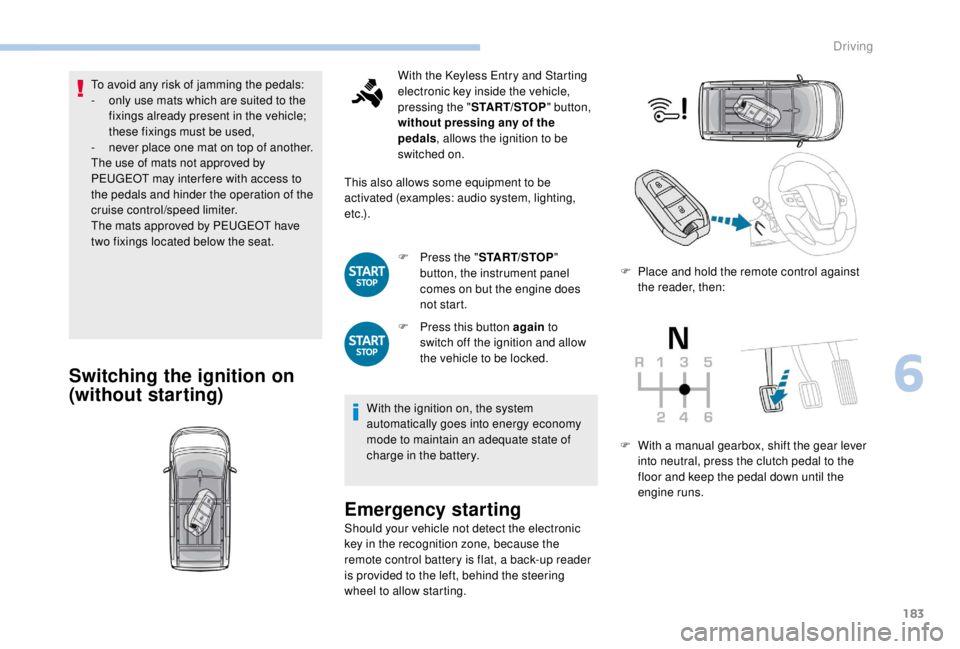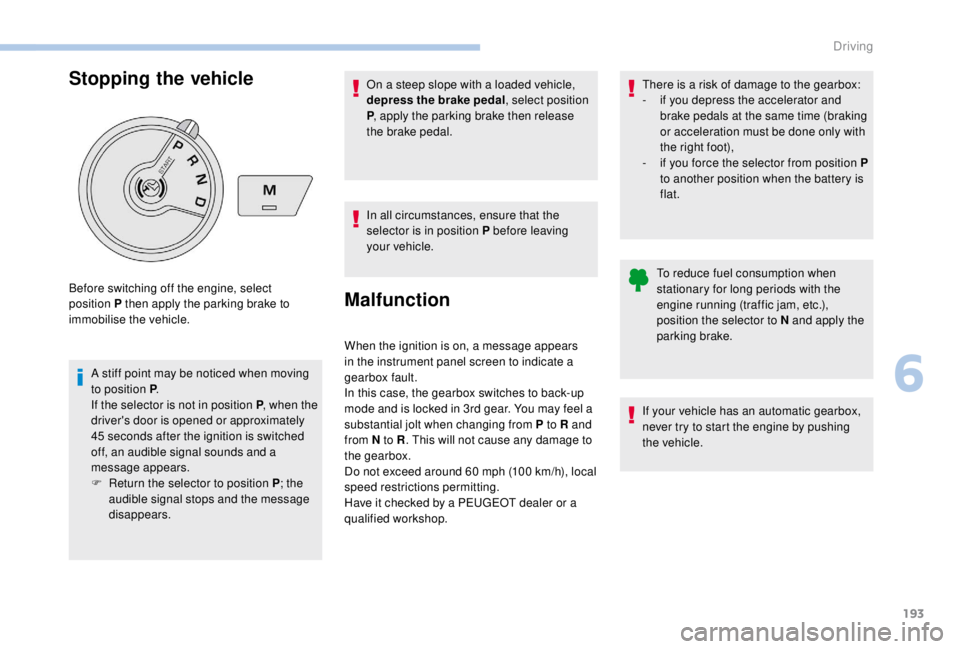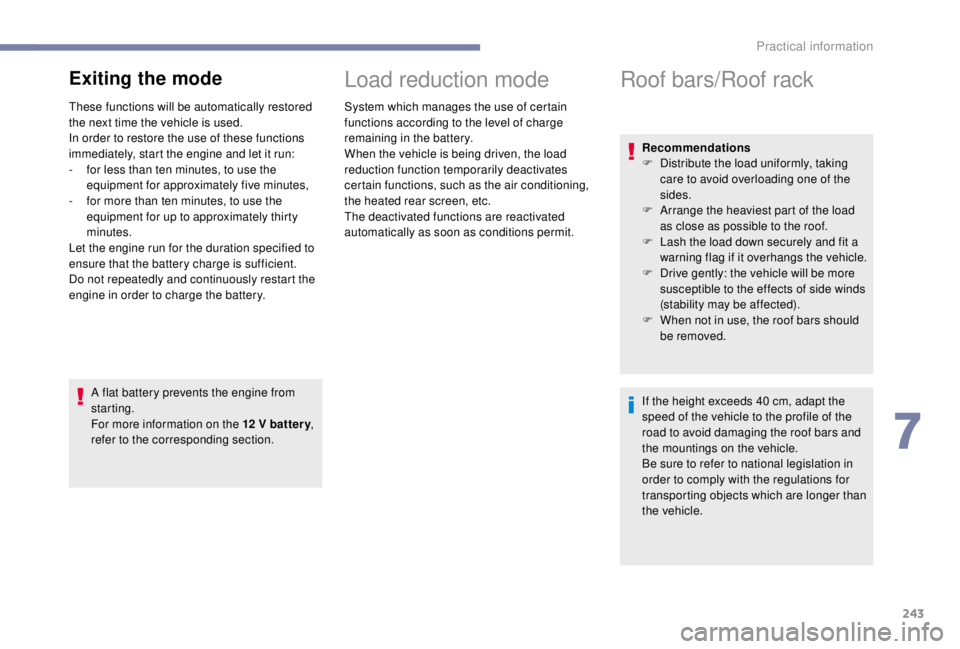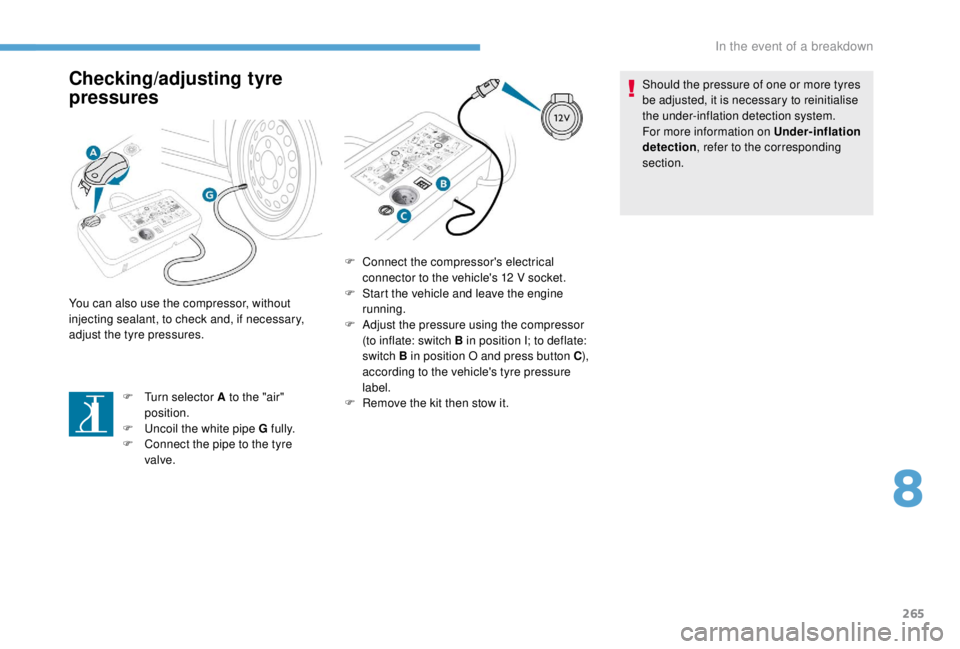2018 PEUGEOT EXPERT run flat
[x] Cancel search: run flatPage 5 of 416

3
.
.
Driving recommendations 176
Starting/switching off the engine,
manual key, remote control
1
78
Starting/switching off the engine,
Keyless Entry and Starting
1
81
Anti-theft protection
1
85
Parking brake
1
85
Hill start assist
1
86
5-speed manual gearbox
1
87
6-speed manual gearbox
1
87
Gear shift indicator
1
88
Automatic gearbox
1
89
Electronic gearbox
1
94
Stop & Start
1
98
Head-up display
2
00
Memorising speeds
2
02
Recognition of speed limit signs and
recommendation
202
Spe
ed limiter
20
6
Cruise control
2
09
Adaptive cruise control
2
11
Collision Risk Alert and Active
Safety Brake
2
18
Lane departure warning system
2
22
Fatigue detection system
2
23
Blind spot monitoring system
2
25
Parking sensors
2
27
Reversing camera, interior mirror
2
29
Visiopark 1
2
30
Under-inflation detection
23
4Fuel
237
Diesel misfuel prevention 23 8
Compatibility of fuels
2
40
Snow chains
2
41
Towing a trailer
2
42
Energy economy mode
2
42
Load reduction mode
2
43
Roof bars/Roof rack
2
43
Changing a wiper blade
2
45
Bonnet
246
Engine
247
Checking levels
2
47
Checks
2
50
AdBlue
® (BlueHDi engines) 2 52
Advice on care 2 56
Warning triangle
2
57
Running out of fuel (Diesel)
2
57
Tool box
2
58
Temporary puncture repair kit
2
60
Spare wheel
26
6
Changing a bulb
2
72
Changing a fuse
2
83
12
V battery
2
88
To w i n g
2
9 2Characteristics of the engines and
towed loads
2
94
Dimensions
301
Identification markings
3
05
PEUGEOT Connect Nav
PEUGEOT Connect Radio
Bluetooth audio system
Driving Practical information
In the event of a breakdown Technical data
Alphabetical index
Audio equipment and telematics
.
Contents
Page 185 of 416

183
To avoid any risk of jamming the pedals:
- o nly use mats which are suited to the
fixings already present in the vehicle;
these fixings must be used,
-
n
ever place one mat on top of another.
The use of mats not approved by
PEUGEOT may inter fere with access to
the pedals and hinder the operation of the
cruise control/speed limiter.
The mats approved by PEUGEOT have
two fixings located below the seat.
Switching the ignition on
(without starting)
With the Keyless Entry and Starting
electronic key inside the vehicle,
pressing the " START/STOP " button,
without pressing any of the
pedals , allows the ignition to be
switched on.
This also allows some equipment to be
activated (examples: audio system, lighting,
e t c .) .
F
P
ress the " START/STOP "
button, the instrument panel
comes on but the engine does
not start.
F
P
ress this button again to
switch off the ignition and allow
the vehicle to be locked.
With the ignition on, the system
automatically goes into energy economy
mode to maintain an adequate state of
charge in the battery.
Emergency starting
Should your vehicle not detect the electronic
key in the recognition zone, because the
remote control battery is flat, a back-up reader
is provided to the left, behind the steering
wheel to allow starting. F
P
lace and hold the remote control against
the reader, then:
F
W
ith a manual gearbox, shift the gear lever
into neutral, press the clutch pedal to the
floor and keep the pedal down until the
engine runs.
6
Driving
Page 195 of 416

193
Stopping the vehicle
A stiff point may be noticed when moving
to position P.
If the selector is not in position P , when the
driver's door is opened or approximately
45
seconds after the ignition is switched
off, an audible signal sounds and a
message appears.
F
R
eturn the selector to position P ; the
audible signal stops and the message
disappears.
Before switching off the engine, select
position P then apply the parking brake to
immobilise the vehicle.
To reduce fuel consumption when
stationary for long periods with the
engine running (traffic jam, etc.),
position the selector to N and apply the
parking brake.
If your vehicle has an automatic gearbox,
never try to start the engine by pushing
the vehicle.
On a steep slope with a loaded vehicle,
depress the brake pedal, select position
P
, apply the parking brake then release
the brake pedal.
In all circumstances, ensure that the
selector is in position P before leaving
your vehicle.
Malfunction
When the ignition is on, a message appears
in the instrument panel screen to indicate a
gearbox fault.
In this case, the gearbox switches to back-up
mode and is locked in 3rd gear. You may feel a
substantial jolt when changing from P to R and
from N to R . This will not cause any damage to
the gearbox.
Do not exceed around 60
mph (100 km/h), local
speed restrictions permitting.
Have it checked by a PEUGEOT dealer or a
qualified workshop. There is a risk of damage to the gearbox:
-
i
f you depress the accelerator and
brake pedals at the same time (braking
or acceleration must be done only with
the right foot),
-
i
f you force the selector from position P
to another position when the battery is
flat.
6
Driving
Page 245 of 416

243
Exiting the mode
These functions will be automatically restored
the next time the vehicle is used.
In order to restore the use of these functions
immediately, start the engine and let it run:
-
f
or less than ten minutes, to use the
equipment for approximately five minutes,
-
f
or more than ten minutes, to use the
equipment for up to approximately thirty
minutes.
Let the engine run for the duration specified to
ensure that the battery charge is sufficient.
Do not repeatedly and continuously restart the
engine in order to charge the battery.
A flat battery prevents the engine from
starting.
For more information on the 12
V batter y,
refer to the corresponding section.
Load reduction mode
System which manages the use of certain
functions according to the level of charge
remaining in the battery.
When the vehicle is being driven, the load
reduction function temporarily deactivates
certain functions, such as the air conditioning,
the heated rear screen, etc.
The deactivated functions are reactivated
automatically as soon as conditions permit.
Roof bars/Roof rack
Recommendations
F D istribute the load uniformly, taking
care to avoid overloading one of the
sides.
F
A
rrange the heaviest part of the load
as close as possible to the roof.
F
L
ash the load down securely and fit a
warning flag if it overhangs the vehicle.
F
D
rive gently: the vehicle will be more
susceptible to the effects of side winds
(stability may be affected).
F
W
hen not in use, the roof bars should
be removed.
If the height exceeds 40
cm, adapt the
speed of the vehicle to the profile of the
road to avoid damaging the roof bars and
the mountings on the vehicle.
Be sure to refer to national legislation in
order to comply with the regulations for
transporting objects which are longer than
the vehicle.
7
Practical information
Page 265 of 416

263
If after around five to seven minutes this
pressure is not reached, this indicates
that the tyre is not repairable; contact a
PEUGEOT dealer or a qualified workshop
for assistance.
F
S
tart the compressor by placing switch B
at the I position and leave it running until
the tyre pressure reaches 2.0 bar. The
sealant product is injected into the tyre
under pressure; do not disconnect the pipe
from the valve during this operation (risk of
blowback). F
R
emove the kit and screw the cap back on
the white pipe. Take care to avoid staining
your vehicle with traces of fluid. Keep the kit
within reach.2. Inflation
F Turn selector A to the "air" position.
F
U
ncoil the white pipe G fully.
F
C
onnect the white pipe to the tyre valve.
As soon as possible, go to a PEUGEOT
dealer or a qualified workshop.
You must inform the technician that you
have used this kit. After inspection, the
technician will let you know if the tyre can
be repaired or if it must be replaced.
F
C
onnect the compressor's electric
connector once again to the vehicle's 12
V
socket.
F
R
estart the vehicle and leave the engine
running.
F
D
rive immediately for approximately three
miles (five kilometres), at reduced speed
(between 12-37 mph (20
and 60
km/h)), to
plug the puncture.
F
S
top to check the repair and the tyre
pressure using the kit.
8
In the event of a breakdown
Page 267 of 416

265
Checking/adjusting tyre
pressures
F Turn selector A to the "air" position.
F
U
ncoil the white pipe G fully.
F
C
onnect the pipe to the tyre
valve.
You can also use the compressor, without
injecting sealant, to check and, if necessary,
adjust the tyre pressures.
F
C
onnect the compressor's electrical
connector to the vehicle's 12 V socket.
F
S
tart the vehicle and leave the engine
running.
F
A
djust the pressure using the compressor
(to inflate: switch B in position I; to deflate:
switch B in position O and press button C ),
according to the vehicle's tyre pressure
label.
F R emove the kit then stow it. Should the pressure of one or more tyres
be adjusted, it is necessary to reinitialise
the under-inflation detection system.
For more information on Under-inflation
detection
, refer to the corresponding
section.
8
In the event of a breakdown
Page 291 of 416

289
F Start the engine of the vehicle with the good battery and leave it running for a few
minutes.
F
O
perate the starter on the broken down
vehicle and let the engine run.
If the engine does not start straight away,
switch off the ignition and wait a few moments
before trying again. F
W
ait for it to return to idle.
F
D
isconnect the jump lead cables in reverse
o r d e r.
F
R
efit the plastic cover to the (+) terminal, if
your vehicle has one.
F
A
llow the engine to run for at least
30 minutes, by driving or with the vehicle
stationary, so that the battery reaches an
adequate state of charge.
To disconnect, proceed in reverse order.
Some functions, including Stop & Start,
are not available if the battery is not
sufficiently charged.
Charging the battery using
a battery charger
For optimum ser vice life of the battery, it is
essential to maintain an adequate state of
charge.
In some circumstances it may be necessary to
charge the battery:
-
i
f you only use your vehicle for short
journeys,
-
i
f the vehicle is to be taken off the road for
several weeks.
Contact a PEUGEOT dealer or a qualified
workshop.
If you wish to charge your vehicle's battery
yourself, use only a charger compatible
with lead-acid batteries with a nominal
voltage of 12 V.
F
L
ift the plastic cover on the (+) terminal, if
your vehicle has one.
F
C
onnect the red cable to the positive
terminal (+) of flat battery A (at the metal
elbow) then to the positive terminal (+) of
back-up battery B or the booster.
F
C
onnect one end of the green or black
cable to the negative terminal (-) of back-up
battery B or the booster (or an earth point
on the other vehicle).
F
C
onnect the other end of the green or black
cable to earth point C on the broken down
vehicle.
Follow the instructions provided by the
manufacturer of the charger.
Never reverse polarities.
It is not necessary to disconnect the
battery.
8
In the event of a breakdown
Page 408 of 416

310
SSafety, children .....................154, 157-160, 164,
16 8 -170, 172-173
Saturation of the particle filter (Diesel)
.........2 51
Screen, instrument panel
..........................35-36
Screen menu map
........................................... 13
Screen, multifunction (with audio system)
........4
Screenwash
.................................................. 140
Screenwash, rear
.......................................... 13 9
SCR (Selective Catalytic Reduction)
............252
Seat and bench seat, rear, fixed
............102-105
Seat and bench seat, rear, on rails
...............105
Seat belts
...................................... 15 0 -15 3, 163
Seat belts, rear
.............................................. 151
Seat, bench front, 2-seat
........................ 9
2 , 151
Seat, rear bench
........................................... 105RRadio ................................... 23 -24, 27, 7, 11, 4- 6
Radio, digital (Digital Audio Broadcasting – DAB)
............................25, 9, 6
Range
........................................................ 36 -37
Range, AdBlue
........................................... 31- 32
RDS
................
....................................... 24-25, 7
Rear screen, demisting
..........................121-12 2
Recharging the battery
.........................289-290
Recirculation, air
............................. 117-11 8 , 12 0
Reduction of electrical load
..........................243
Regeneration of the particle filter
.................2 51
Reinitialisation of the under- inflation detection system
...........................235
Reinitialising the remote control
... 4
5 - 46, 59 - 60
Reminder, key in ignition
...............................18
1Reminder, lighting on
.............................
13
1-132
Remote control
.......................
39 - 42, 44, 46 -50,
57-61, 63-64
Removing a wheel ................................
2 6 9 -271
Removing the mat
.........................................
108
Replacing bulbs
..................... 2
72-273, 278-282
Replacing fuses
....................................
283-286
Replacing the air filter
................................... 25
0
Replacing the oil filter
................................... 25
0
Replacing the passenger compartment filter
......................................
250
Reservoir, headlamp wash
........................... 24
9
Reservoir, screenwash
.................................
249
Reset journey
.................................................. 36
R
esetting the service indicator
.......................
29
Resetting the trip recorder
........................
33-34
Reversing camera
...............................
..
230-233
Reversing camera (on interior mirror) ..........
229
Reversing lamp
............................
278, 280, 282
Roof bars
...............................................
243 -244
Running out of fuel (Diesel) ..........................
257
Pads, brake
............................................
251-252
Paint colour code ..........................................
305
Parking brake
...........................
14, 185, 251-252
Parking sensors, audible and visual
.....
228-229
Parking sensors, front
...........................
228-229
Parking sensors, rear ............................227-229
Passenger's airbag
......................................... 20
P
EUGEOT Connect Nav ...................................
1
PEUGEOT Connect Radio
...............................
1
P
lates, identification
...................................... 305
Player, Apple
® ...................................... 2 7, 11, 10
Player, MP3
CD ............................... ......2 6 , 9 -10
Player, USB
........................................... 26, 10, 8
Port, USB
...................................... 111, 26, 10, 8
Power steering
...............................
.................21
Pressures, tyres
............................ 261, 265, 305
Pre-tensioning seat belts
.............................. 15 3
Priming the fuel system
................................ 257
Profiles
...................................................... 3 4, 18
Protecting children
................ 154, 157-160, 164,
16 8 -170, 172-173
Puncture
................................................ 260-265
PSeats, electric ........................................... 89-90
Seats, front ............................... ...........87, 89 -90
Seats, heated
............................................ 91-93
Seats, rear
............................................... 9 9 -10 4
Selector, gear
......................................... 19 4 -197
Serial number, vehicle
..................................305
Service indicator
....................................... 2 7, 2 9
Servicing
......................................................... 2
7
Settings, system
........................................ 35, 19
Sidelamps
............. 1
30, 273 -275, 278, 280, 282
Side repeater
................................................ 2 74
Sliding side door, electric
....................... 41- 42, 48, 54-56, 66 -73
Sliding side door, hands-free
.....................74 -7 6
Sliding side door, manual
................... 6
4- 66, 70
Sliding side window
...................................... 11
4
Snow chains
.................................. 234, 241, 268
Snow chains, link
.................................. 2 41, 2 6 8
Socket, 12
V accessory ................................111
Socket, auxiliary
.................................... 2
6, 10, 9
Socket, JACK
................................ 112, 26, 10, 9
Sockets, audio
........................................ 111
-112
Speed limiter
................................. 202
, 204-208
Speed limit recognition
........................ 20
2-204,
206 -215, 217-218
Stability control (ESC)...................... 21, 145 -14 6
Starting a Diesel engine
............................... 24
0
Starting the engine
................................ 17
8 -179
Starting the vehicle
....................... 18
1, 183 -18 4,
18 6, 189 -197
Starting using another battery
......................288
Station, radio
...............................
.......23 -25, 7, 4
Stay, bonnet
.................................................. 246
Steering mounted controls, audio
............ 3
, 3, 3
Steering wheel, adjustment
............................ 85
S
topping the vehicle
...............181-18 4, 189 -197
Stop & Start
........................ 19, 25, 37, 121, 124,
198 -200, 237, 246, 291
Stop (warning lamp)
........................................ 14
Storage
...................................... 9 4, 98, 10 6 -109
Alphabetical index